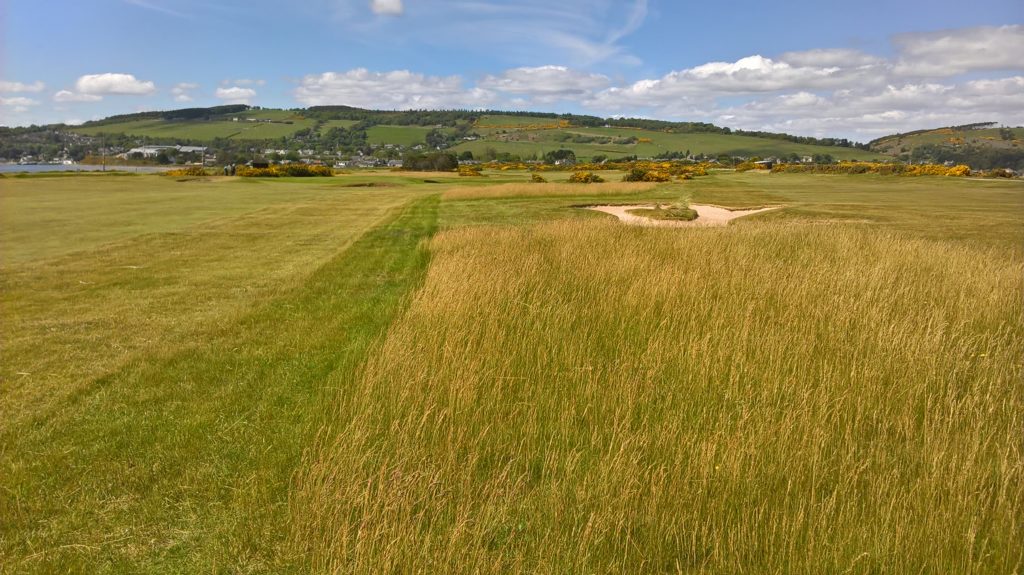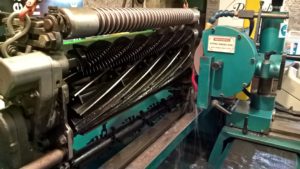5thApril 2024
It’s been a long, wet and cold Winter and Spring has been no better so far. I don’t think I can remember loosing the feeling in my fingers from cold weather at the start of April but so much for global warming!!
Nevertheless our greens team have persevered through some pretty miserable weather these past few months and have to be congratulated on their efforts and dedication. Refreshing of around 20 bunker faces completed, a new bunker on the 8th dogleg, re painting of all the on course furniture, fencing repairs, whin management to name a few. Photo – new Apprentice Kieran getting in his step count.
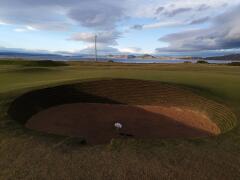 7th greenside bunker
7th greenside bunker
Work on the greens took place in February when we gave them a solid spike followed by a Graden scarify and a heavy top dressing. This was quite aggressive at the time and happily they settled down fairly quickly after a week or two and much improved after another couple of dressings of sand. Growth has been extremely slow this year so far and we have only just lowered the mowers to 4.5mm. Our next target is a star spike and a little refinement with the verti cut units, a liquid spray of seaweed/molasses/humic acid and Nitrogen, some more light sand dressings and a Spring feed towards the end of the month. If we can get a wet day without any wind then our first application of wetting agent will go on.
Onto the fairways which have had a good rest from divots through the winter. Many thanks to the members for putting up with using mats as it certainly helps with recovery for the main playing season. We have been patching the fairways regularly since the mats were lifted and it is good to see that many divots are being replaced by golfers. The downside just now are the birds which are turning over divots in their search for Leatherjacket grubs which are emerging from the soils just now. These little blighters eat away at the grass roots and subsequently stunt growth throughout the season and is something we could do without! Although the weather has been relatively poor we still have a high footfall over the course all Winter and Spring which creates a lot of compaction. Our new Gxi8 spiker was put to good use in December when we got all the fairways spiked thus helping relieve some of this compaction and also loosen the soils a bit to aid in turf vigor. More sand has also been applied to seven of our weaker fairways and this seems to be working well. Also a pellet fertiliser feed has gone onto 1,2,3,4,7,8,12 and 13th fairways recently to help strengthen up any newly germinating seed that was sewn last Autumn. Again if we can get some calmer winds in amongst this wetter weather then all the fairways will be treated with wetting agent to counteract any drier weather forthcoming.
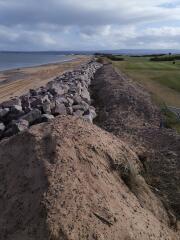 Coastal erosion. Note. Last Autumns high tidal surge coincided with one of the lowest atmospheric pressure readings since 1916. As you are aware plenty work has gone on at the 1st and 2nd holes over the past few weeks. Rock armour has been placed by GF Job at the 1st and 2nd tees to protect these most important areas. In between a short term fix of sand and Marram which was salvaged or reclaimed from the far end of the course and built up back to the exposed manhole covers and re gaining the core path once again. Two rows of chestnut fencing has been staked in to help protect this sand material and aid in any Marram regrowth. Subsequently and unfortunately last weeks high tide has taken a fair chunk of the sand away from the beach edge and some of the fencing will have to be moved inwards. . Long term this area can be re charged with sand and backed up with rock armour when enough funds are raised and become available. The core path area is to be soiled and seeded shortly to restore grass onto it and will be roped off meantime.
Coastal erosion. Note. Last Autumns high tidal surge coincided with one of the lowest atmospheric pressure readings since 1916. As you are aware plenty work has gone on at the 1st and 2nd holes over the past few weeks. Rock armour has been placed by GF Job at the 1st and 2nd tees to protect these most important areas. In between a short term fix of sand and Marram which was salvaged or reclaimed from the far end of the course and built up back to the exposed manhole covers and re gaining the core path once again. Two rows of chestnut fencing has been staked in to help protect this sand material and aid in any Marram regrowth. Subsequently and unfortunately last weeks high tide has taken a fair chunk of the sand away from the beach edge and some of the fencing will have to be moved inwards. . Long term this area can be re charged with sand and backed up with rock armour when enough funds are raised and become available. The core path area is to be soiled and seeded shortly to restore grass onto it and will be roped off meantime.
Looking ahead to the season now upon us it would be nice to get some warmer weather and some more consistent grass growth.
George Paterson
Head Greenkeeper


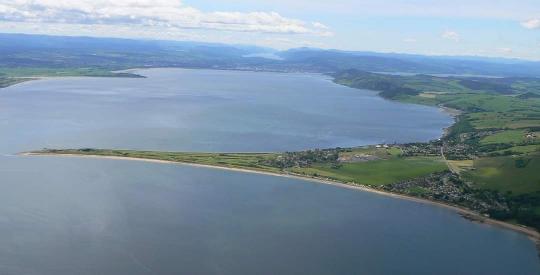
 helps dilute fibre and in turn promote better soil characteristics for fine grass to tiller into. Some more selective sanding will go on.
helps dilute fibre and in turn promote better soil characteristics for fine grass to tiller into. Some more selective sanding will go on.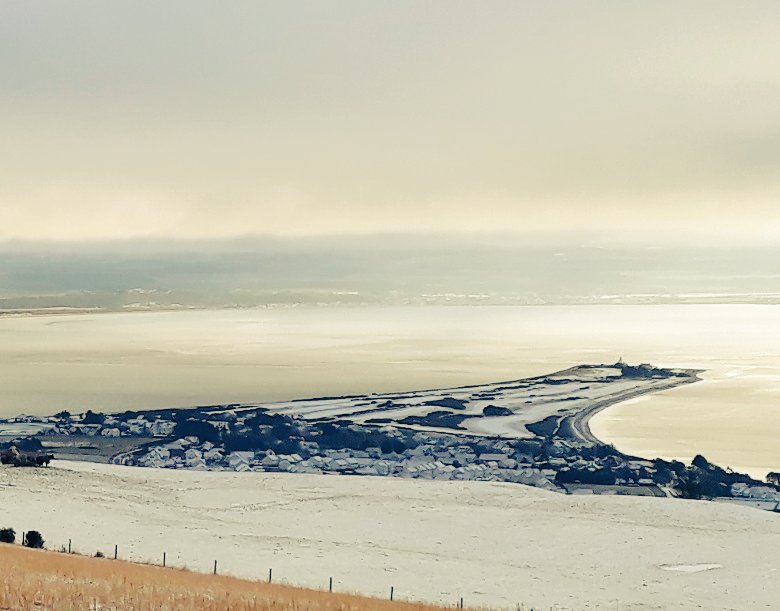
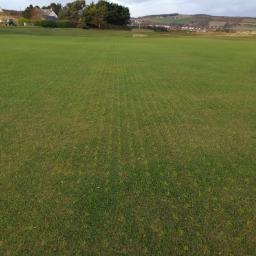
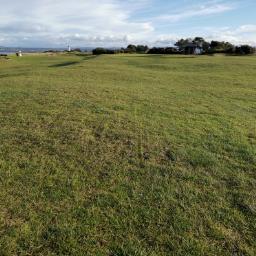
 We also dug out the last group of whins on the left of the 4th fairway which gathered a lot of golf balls. We have created another sandscrape which will again catch the stray shot and make for a tricky recovery, meanwhile speeding up play.
We also dug out the last group of whins on the left of the 4th fairway which gathered a lot of golf balls. We have created another sandscrape which will again catch the stray shot and make for a tricky recovery, meanwhile speeding up play.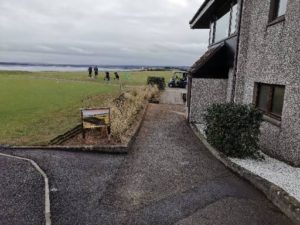
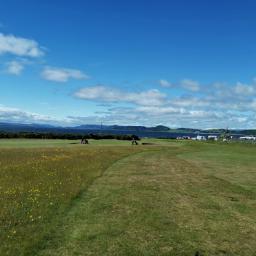
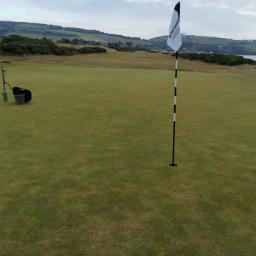 greens in an effort to re wet these bits. We also gave all the greens a close pencil tine down to 5″ to help enable any water to penetrate more evenly. We have more wetting agent to go on at the next opportunity which will hopefully bring back a full recovery. My thoughts are that the Meadow grass (Poa) component in the sward doesn’t like the dry weather and will always be susceptible in weather extremes and when the greens are pushed for speed. The fertility in the greens is also low and particularly the sandier greens which suggests that a light organic feed is imminent and would benefit things overall for the rest of the playing season. We are currently cutting at 3.7mm which is low enough for our site and greens make up but ultimately, if players want faster greens then the greens swards will require more Fescue grasses.
greens in an effort to re wet these bits. We also gave all the greens a close pencil tine down to 5″ to help enable any water to penetrate more evenly. We have more wetting agent to go on at the next opportunity which will hopefully bring back a full recovery. My thoughts are that the Meadow grass (Poa) component in the sward doesn’t like the dry weather and will always be susceptible in weather extremes and when the greens are pushed for speed. The fertility in the greens is also low and particularly the sandier greens which suggests that a light organic feed is imminent and would benefit things overall for the rest of the playing season. We are currently cutting at 3.7mm which is low enough for our site and greens make up but ultimately, if players want faster greens then the greens swards will require more Fescue grasses.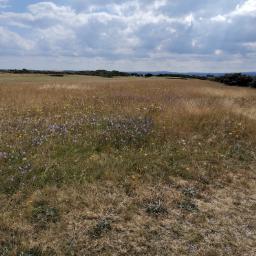 Our roughs have pretty much looked after themselves this summer with no summer cut required as they have thinned out with the dry weather. Plenty of colour in them with with dandelions and wild flowers here and there. A cut and collect will be done end of season.
Our roughs have pretty much looked after themselves this summer with no summer cut required as they have thinned out with the dry weather. Plenty of colour in them with with dandelions and wild flowers here and there. A cut and collect will be done end of season.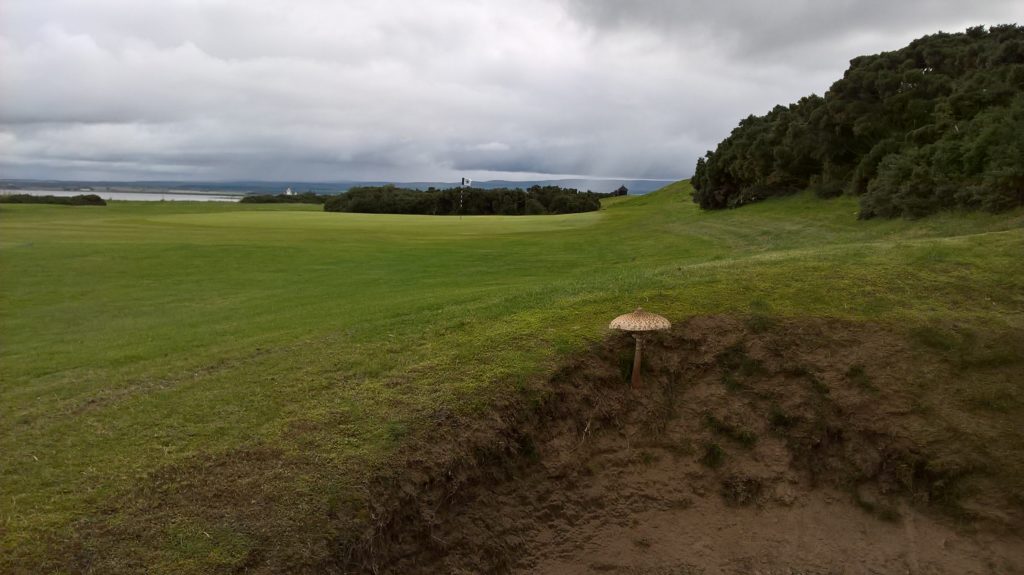
 Hopefully we will get the fairways deep slit a couple of times this winter and do some much needed verti-drain work. An iron spray will also go on in the next few weeks to knock back any mossy areas.
Hopefully we will get the fairways deep slit a couple of times this winter and do some much needed verti-drain work. An iron spray will also go on in the next few weeks to knock back any mossy areas.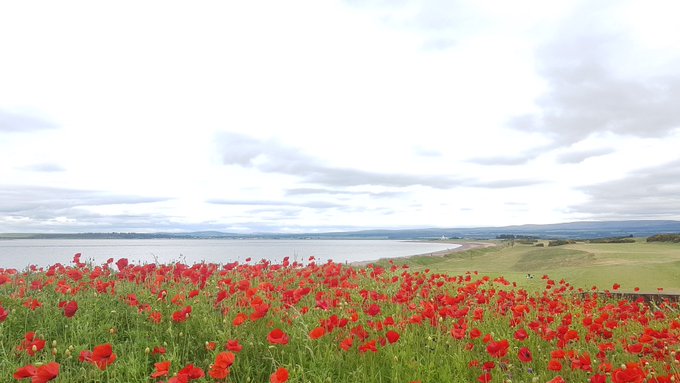
 With the recent dry weather cutting has eased off a bit on the fairways and are only being cut as necessary to avoid any unnecessary additional stress. We have been relentlessly patching and tidying the fairways each week this year with the high level of play and birds turning over divots in search of Leatherjackets. Warne, our new summer labourer has helped greatly along with our staff in keeping the place neat and tidy. We intend not to broadcast spray the fairways for weeds again this year and just to spot treat with the knapsack over the next few weeks. Mainly isolated plantains to deal with here and there. The greens surrounds were blanket sprayed back in early June treating mainly plantains, daisies and bits of clover.
With the recent dry weather cutting has eased off a bit on the fairways and are only being cut as necessary to avoid any unnecessary additional stress. We have been relentlessly patching and tidying the fairways each week this year with the high level of play and birds turning over divots in search of Leatherjackets. Warne, our new summer labourer has helped greatly along with our staff in keeping the place neat and tidy. We intend not to broadcast spray the fairways for weeds again this year and just to spot treat with the knapsack over the next few weeks. Mainly isolated plantains to deal with here and there. The greens surrounds were blanket sprayed back in early June treating mainly plantains, daisies and bits of clover.

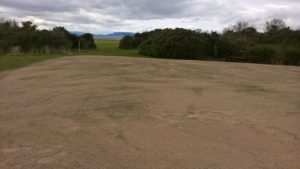 and firming the surfaces up. An Iron and Ammonia spray has gone on last week and a granular feed and wetting agent is planned next.
and firming the surfaces up. An Iron and Ammonia spray has gone on last week and a granular feed and wetting agent is planned next.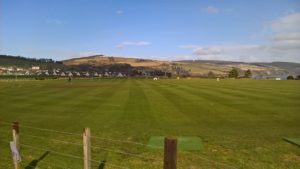 The range got its first cut this week and is looking great. The downside is that it took almost 2 hours to rake up all the divots and collect golf balls before it could get cut. This is time we can ill afford with a small team of four greenstaff. It would help us greatly if the mats provided could be used or if hitting from the grass then a couple of minutes spent replacing your divots after would be greatly appreciated. Can I remind also that no iron play from behind the main mat and please do not leave divots sprayed over any of the small greens on the range. Thank you.
The range got its first cut this week and is looking great. The downside is that it took almost 2 hours to rake up all the divots and collect golf balls before it could get cut. This is time we can ill afford with a small team of four greenstaff. It would help us greatly if the mats provided could be used or if hitting from the grass then a couple of minutes spent replacing your divots after would be greatly appreciated. Can I remind also that no iron play from behind the main mat and please do not leave divots sprayed over any of the small greens on the range. Thank you.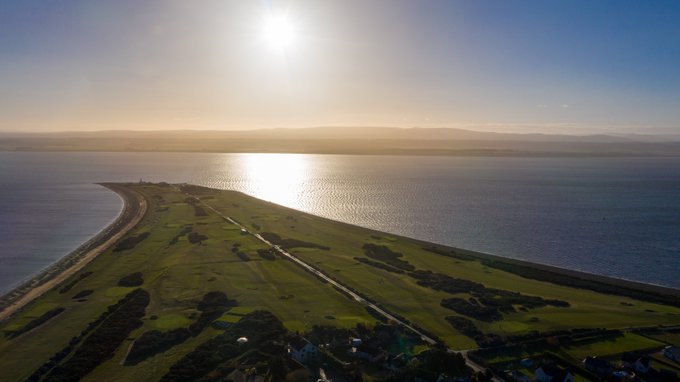
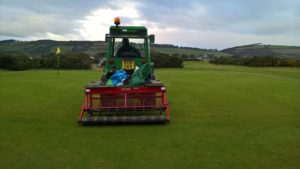 Micro hollow tining is planned for around mid February. Fairways and greens surrounds have also been slit with some fairways receiving a sanding also. In November we sprayed Iron to all areas apart from the longer roughs in our combat against moss and this will be done again in the spring along with some Ammonia (Nitrogen) and wetting agent.
Micro hollow tining is planned for around mid February. Fairways and greens surrounds have also been slit with some fairways receiving a sanding also. In November we sprayed Iron to all areas apart from the longer roughs in our combat against moss and this will be done again in the spring along with some Ammonia (Nitrogen) and wetting agent. Up turned turf is used in the bases to both provide a firm base and also to keep stones from coming through. These will be topped up with sand around early March and brought into play for the first competitions. Proposal – The twin bunkers on the 15th fairway have been earmarked for a redesign into one large bunker. Back in the early 90s this was to be the case but while digging out the bunker we came across the irrigation pipe and had to split the bunker into two. The new irrigation line now runs past the right hand side of the bunkers therefore allowing these bunkers to be improved and made into something more aesthetically pleasing.
Up turned turf is used in the bases to both provide a firm base and also to keep stones from coming through. These will be topped up with sand around early March and brought into play for the first competitions. Proposal – The twin bunkers on the 15th fairway have been earmarked for a redesign into one large bunker. Back in the early 90s this was to be the case but while digging out the bunker we came across the irrigation pipe and had to split the bunker into two. The new irrigation line now runs past the right hand side of the bunkers therefore allowing these bunkers to be improved and made into something more aesthetically pleasing. The large obtrusive section of gorse has been removed to open up the fairway view from the tee. The natural sand base has been exposed to create an in play sand scrape and this will both help speed up play and allow you to see where your ball goes.
The large obtrusive section of gorse has been removed to open up the fairway view from the tee. The natural sand base has been exposed to create an in play sand scrape and this will both help speed up play and allow you to see where your ball goes.